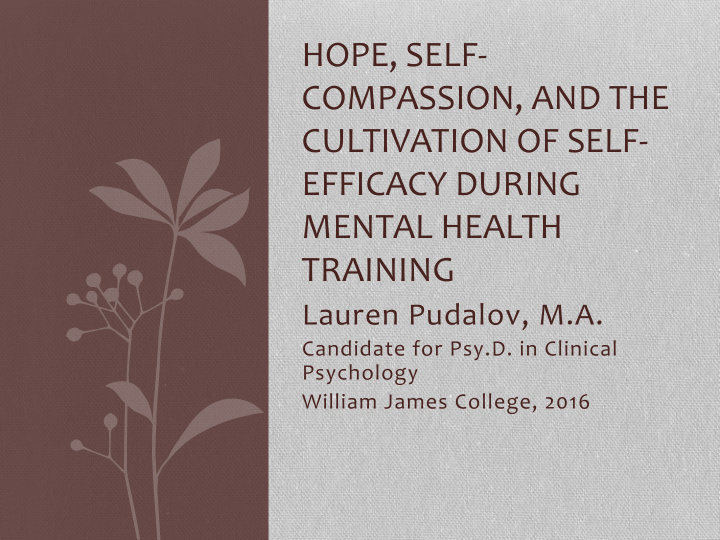



HOPE, ¡SELF-‑ COMPASSION, ¡AND ¡THE ¡ CULTIVATION ¡OF ¡SELF-‑ EFFICACY ¡DURING ¡ MENTAL ¡HEALTH ¡ TRAINING ¡ Lauren ¡Pudalov, ¡M.A. ¡ Candidate ¡for ¡Psy.D. ¡in ¡Clinical ¡ Psychology ¡ ¡ William ¡James ¡College, ¡2016 ¡ ¡ ¡
Acknowledgements ¡ • My ¡Committee ¡ ¡ • Claire ¡Fialkov, ¡Ph.D. ¡ • Shyamala ¡Venkataraman, ¡Ph.D. ¡ • Don ¡Chase, ¡Psy.D., ¡MPH ¡ • Judith ¡Jordan, ¡Ph.D. ¡(Discussant) ¡ • Statistics ¡extraordinaires ¡ ¡ • Laura ¡Wainwright, ¡Ph.D. ¡ • Gemima ¡St. ¡Louis, ¡Ph.D. ¡ • My ¡Professors ¡and ¡supervisors ¡ • My ¡family ¡ ¡ • My ¡friends ¡ ¡ ¡
Presentation ¡Outline ¡ • Research ¡Question ¡and ¡Hypotheses ¡ • Introduction ¡ • Definition ¡of ¡Key ¡Terms ¡ • Literature ¡Review ¡ • Methods ¡ • Results ¡ • Implications ¡ ¡ • Reflections/Questions ¡
Research ¡Question ¡and ¡Hypotheses ¡ ¡ • Primary ¡research ¡question: ¡ • What ¡is ¡the ¡relationship ¡between ¡trainee ¡clinician ¡self-‑efficacy, ¡hopefulness, ¡ and ¡self-‑compassion? ¡ • Hypotheses: ¡ • Hope ¡and ¡self-‑compassion ¡would ¡be ¡positively ¡correlated ¡with ¡each ¡other ¡ and ¡with ¡self-‑efficacy. ¡ • There ¡would ¡be ¡a ¡stronger ¡positive ¡relationship ¡with ¡self-‑efficacy ¡when ¡the ¡ effects ¡of ¡hope ¡and ¡self-‑compassion ¡are ¡combined. ¡
Introduction ¡ • Multifaceted ¡stressors ¡of ¡being ¡a ¡psychology ¡graduate ¡student ¡and ¡ the ¡subsequent ¡physical, ¡mental, ¡and ¡psychological ¡outcomes ¡ (Cushway ¡& ¡Tyler, ¡1992). ¡ • Scarcity ¡of ¡research ¡on ¡factors ¡that ¡promote ¡wellness, ¡learning, ¡and ¡ self-‑confidence. ¡ • Clinician ¡self-‑efficacy ¡associated ¡with ¡positive ¡outcomes ¡such ¡as ¡ increased ¡professional ¡satisfaction ¡and ¡positive ¡affective ¡ experiences ¡as ¡well ¡as ¡decreased ¡anxiety ¡in ¡clinical ¡contexts ¡ (Ducharme, ¡Knudsen, ¡& ¡Roman, ¡2008). ¡
Definition ¡of ¡Key ¡Terms ¡ ¡ • Hope ¡ • Future-‑oriented ¡way ¡of ¡thinking ¡that ¡incorporates ¡individuals’ ¡capacities ¡to ¡set ¡ incremental ¡goals ¡toward ¡a ¡purposeful ¡end ¡(Snyder ¡et ¡al., ¡1991). ¡ • Self-‑Compassion ¡ • “Being ¡open ¡to ¡and ¡moved ¡by ¡one’s ¡own ¡suffering, ¡experiencing ¡feelings ¡of ¡ caring ¡and ¡kindness ¡toward ¡oneself, ¡taking ¡an ¡understanding, ¡nonjudgmental ¡ attitude ¡toward ¡one’s ¡inadequacies ¡and ¡failures, ¡and ¡recognizing ¡that ¡one’s ¡ experiences ¡are ¡part ¡of ¡the ¡common ¡human ¡experience ¡(Neff, ¡2003a, ¡p. ¡224). ¡ • Self-‑Efficacy ¡ • “People’s ¡judgments ¡of ¡their ¡capabilities ¡to ¡organize ¡and ¡execute ¡course ¡of ¡ action ¡required ¡to ¡attain ¡designated ¡types ¡of ¡performances ¡(Bandura, ¡1986, ¡p. ¡ 39). ¡ • Counselor ¡Self-‑Efficacy ¡ • Clinicians’ ¡beliefs ¡about ¡their ¡ability ¡to ¡engage ¡in ¡counseling-‑related ¡behaviors ¡ and ¡their ¡capacity ¡to ¡manage ¡diverse ¡clinical ¡situations ¡(Larson ¡& ¡Daniels, ¡ 1998). ¡ ¡
Review ¡of ¡the ¡Literature ¡ ¡ • Trainee ¡Professional ¡Development ¡ • Stress ¡and ¡the ¡Mental ¡Health ¡Professional ¡ • Theoretical ¡framework: ¡Social ¡Cognitive ¡Theory ¡(SCT) ¡ • Bandura ¡(1977) ¡coined ¡the ¡term ¡self-‑efficacy. ¡ • “People ¡are ¡both ¡products ¡and ¡producers ¡of ¡their ¡environment” ¡(Bandura, ¡ 1989, ¡p. ¡4). ¡ • Components ¡of ¡SCT ¡ • The ¡Social ¡Cognitive ¡Model ¡of ¡Counselor ¡Training ¡(SCMCT) ¡ • 4 ¡sources ¡that ¡contribute ¡to ¡self-‑efficacy ¡ • Hopefulness ¡ • 2 ¡appraisal ¡processes ¡ ¡ • Distinction ¡between ¡hope ¡and ¡optimism ¡ • Self-‑Compassion ¡ • 3 ¡core ¡components ¡ • Benefits ¡of ¡self-‑compassion ¡
Methods ¡ • Research ¡questions ¡ • What ¡is ¡the ¡relationship ¡between ¡trainee ¡clinician ¡self-‑efficacy, ¡hopefulness, ¡ and ¡self-‑compassion? ¡ • Do ¡trainee ¡clinician ¡hopefulness ¡and ¡self-‑compassion ¡have ¡a ¡synergistic ¡ effect? ¡ • ¡When ¡hopefulness ¡and ¡self-‑compassion ¡scores ¡are ¡combined, ¡will ¡they ¡correlate ¡ more ¡robustly ¡with ¡trainee ¡clinician ¡self-‑efficacy ¡than ¡when ¡accounted ¡for ¡ separately? ¡ • Hypotheses ¡ • Hope ¡and ¡self-‑compassion ¡would ¡be ¡positively ¡correlated ¡with ¡each ¡other ¡ and ¡with ¡self-‑efficacy. ¡ • There ¡would ¡be ¡a ¡stronger ¡positive ¡relationship ¡with ¡self-‑efficacy ¡when ¡the ¡ effects ¡of ¡hope ¡and ¡self-‑compassion ¡are ¡combined. ¡
Methods ¡continued… ¡ • Research ¡Design ¡ • Online ¡survey ¡format ¡ • Participants ¡ • 147 ¡(mean ¡age ¡= ¡28.68) ¡ ¡ • Masters ¡and ¡Doctorate ¡level ¡clinicians-‑in-‑training ¡ • Recruited ¡from ¡an ¡East ¡coast ¡graduate ¡college ¡of ¡psychology ¡as ¡well ¡as ¡ other ¡programs ¡nationwide ¡ • Predominantly ¡Caucasian ¡ ¡ • Procedures ¡ • Survey ¡Preparation ¡ ¡ • 3-‑part ¡anonymous ¡survey ¡on ¡Qualtrics ¡
Methods ¡continued… ¡ • Soliciting ¡and ¡Enrolling ¡Participants ¡ • Via ¡email ¡and ¡Facebook ¡to ¡personal ¡contacts, ¡graduate ¡schools, ¡and ¡supervisors ¡ • Instructions ¡to ¡Participants ¡ • Informed ¡consent ¡ à ¡demographic ¡information ¡ à ¡3 ¡measures ¡ • Data ¡Storage ¡ • Stored ¡on ¡Qualtrics ¡with ¡encrypted ¡password-‑protected ¡database ¡ • Debriefing ¡ • No ¡potential ¡harmful ¡outcomes ¡ • Researcher ¡provided ¡contact ¡information ¡should ¡participants ¡have ¡any ¡questions ¡ or ¡concerns ¡
Methods ¡continued… ¡ • Measures ¡ • Counselor ¡Activity ¡Self-‑Efficacy ¡Scales ¡(CASES) ¡(Lent ¡et ¡al., ¡2003) ¡ • 41-‑item ¡scale ¡grounded ¡in ¡theories ¡of ¡trainee ¡development ¡ ¡ • 3 ¡subsections ¡ • Helping ¡Skills ¡ • Session ¡Management ¡ • Counseling ¡Challenges ¡ • Self-‑Compassion ¡Scale-‑Short ¡Form ¡(SCS-‑SF) ¡(Raes ¡et ¡al., ¡2011) ¡ • 12-‑item ¡scale ¡ • Encompasses ¡6 ¡sub-‑factors ¡(Self-‑Kindness, ¡Self-‑Judgment, ¡Common ¡Humanity, ¡ Isolation, ¡Mindfulness, ¡and ¡Over-‑Identification). ¡ • Hope ¡Scale ¡(HS) ¡(Snyder ¡et ¡al., ¡1991) ¡ • 12-‑item ¡scale ¡ ¡ • Includes: ¡4 ¡distracter, ¡4 ¡agency, ¡4 ¡pathways ¡items ¡ ¡
Results ¡ • Primary ¡research ¡question ¡ • What ¡is ¡the ¡relationship ¡between ¡trainee ¡clinician ¡self-‑efficacy, ¡hopefulness, ¡ and ¡self-‑compassion? ¡ • Hypotheses ¡ • Hope ¡and ¡self-‑compassion ¡would ¡be ¡positively ¡correlated ¡with ¡each ¡other ¡ and ¡with ¡self-‑efficacy. ¡ • There ¡would ¡be ¡a ¡stronger ¡positive ¡relationship ¡with ¡self-‑efficacy ¡when ¡the ¡ effects ¡of ¡hope ¡and ¡self-‑compassion ¡are ¡combined. ¡ • Demographic ¡results ¡ • Main ¡results ¡ • Correlational ¡analyses ¡(i.e., ¡relationship ¡between) ¡and ¡multiple ¡regressions ¡(i.e., ¡ predictive ¡strength) ¡supported ¡both ¡hypotheses. ¡
Pearson ¡Correlations ¡Between ¡Study ¡Variables ¡ ¡ • Hypothesis: ¡Hope ¡and ¡self-‑compassion ¡are ¡positively ¡correlated ¡with ¡each ¡ other ¡and ¡with ¡self-‑efficacy. ¡ Measure ¡ HS ¡ SCS-‑SF ¡ CASES ¡ HS ¡ .483* ¡ .439* ¡ SCS-‑SF ¡ .329* ¡ Note. ¡*. ¡Correlation ¡is ¡significant ¡at ¡the ¡0.01 ¡level ¡(2-‑tailed). ¡
Recommend
More recommend